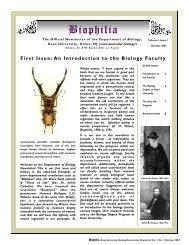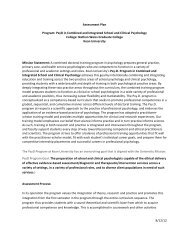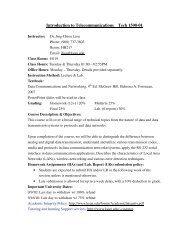Embodying the Sacred in Yoruba Art - Kean University
Embodying the Sacred in Yoruba Art - Kean University
Embodying the Sacred in Yoruba Art - Kean University
You also want an ePaper? Increase the reach of your titles
YUMPU automatically turns print PDFs into web optimized ePapers that Google loves.
The headpiece <strong>in</strong> plate 22 is an example of a hairstyle known as ààso<br />
olúóde (hunter’s knot), which identifies <strong>the</strong> deceased portrayed as a hunter.<br />
The carved gourds (àdó) on <strong>the</strong> forehead refer to those used by hunters for<br />
keep<strong>in</strong>g magical powder that is <strong>in</strong>tended to make <strong>the</strong>m <strong>in</strong>visible to <strong>the</strong> naked<br />
eye and thus allow <strong>the</strong>m to stalk ferocious animals. The three vertical marks<br />
on <strong>the</strong> cheeks and forehead (pélé) beautify <strong>the</strong> face, and <strong>the</strong> beard signifies<br />
wisdom. In addition to adorn<strong>in</strong>g <strong>the</strong> image, <strong>the</strong> necklace of cowrie shells<br />
(owó eyo), which were formerly used as currency, has a votive significance,<br />
implor<strong>in</strong>g <strong>the</strong> ancestor to let liv<strong>in</strong>g descendants prosper <strong>in</strong> <strong>the</strong>ir bus<strong>in</strong>ess<br />
endeavors. The headpiece <strong>in</strong> plate 21 is unusual because of <strong>the</strong> pattern on<br />
its face, which is apparently <strong>in</strong>tended to command attention. At <strong>the</strong> same<br />
time, <strong>the</strong> pattern appears to simulate <strong>the</strong> net normally attached to <strong>the</strong> base<br />
of a typical headdress and through which a masker observes <strong>the</strong> public<br />
without be<strong>in</strong>g seen or recognized.<br />
Although some Egúngún may be identified with or named after specific<br />
ancestors or culture heroes, <strong>the</strong>ir carved headdresses do not attempt<br />
to recapture <strong>in</strong>dividual likeness. Here <strong>the</strong> stylization of <strong>the</strong> human face<br />
is evocative of a translocation from <strong>the</strong> here-and-now to <strong>the</strong> hereafter.<br />
The volum<strong>in</strong>ous costume of a typical Egúngún conceals <strong>the</strong> unknowable,<br />
while at <strong>the</strong> same time reveal<strong>in</strong>g <strong>the</strong> human potential for metaphysical<br />
transformation and regeneration. In short, <strong>the</strong> Egúngún performance<br />
celebrates <strong>the</strong> triumph of <strong>the</strong> human spirit over death.<br />
Gèlèdé: Honor<strong>in</strong>g Women<br />
and Us<strong>in</strong>g Satire to Educate <strong>the</strong> Public<br />
Unlike <strong>the</strong> Egúngún masquerade society, whose activities are closely<br />
guarded and kept away from <strong>the</strong> generality of women (although <strong>the</strong>re<br />
are female members), <strong>the</strong> Gèlèdé is much more open <strong>in</strong> its practices.<br />
For example, <strong>the</strong> veil on <strong>the</strong> rim of <strong>the</strong> carved headpiece is sometimes so<br />
transparent that <strong>the</strong> masquerader is easily identifiable. The masquerade<br />
is found ma<strong>in</strong>ly among <strong>the</strong> Kétu, Ègbádò, Òhòrí, and Àwórì <strong>Yoruba</strong> of<br />
southwestern <strong>Yoruba</strong>land. One of <strong>the</strong> goals of <strong>the</strong> Gèlèdé society is to<br />
cultivate good gender relations by advocat<strong>in</strong>g respect for women with<strong>in</strong><br />
a patriarchal culture, such as that of <strong>the</strong> <strong>Yoruba</strong>, where men dom<strong>in</strong>ate<br />
<strong>the</strong> <strong>in</strong>stitution of k<strong>in</strong>gship. There are two reasons for this pro-female<br />
stance. The first is that <strong>the</strong> preservation of humanity depends on <strong>the</strong> role<br />
of <strong>the</strong> female as mo<strong>the</strong>r, and <strong>the</strong> second has to do with <strong>the</strong> popular belief<br />
that certa<strong>in</strong> <strong>Yoruba</strong> women called àjé (Our Mo<strong>the</strong>rs) have access to <strong>the</strong><br />
mystical power that Olódùmarè gave to <strong>the</strong> first woman, venerated by <strong>the</strong><br />
Gèlèdé society as Ìyá Nlá (<strong>the</strong> Great Mo<strong>the</strong>r). By mediat<strong>in</strong>g between a<br />
given community and Ìyá Nlá as well as <strong>the</strong> àjé, <strong>the</strong> Gèlèdé society attempts<br />
to appease and predispose <strong>the</strong> latter to use <strong>the</strong>ir special endowment for <strong>the</strong><br />
benefit, ra<strong>the</strong>r than <strong>the</strong> destruction, of humank<strong>in</strong>d. 18 One important aspect of<br />
a Gèlèdé masquerade is its use of satire to enterta<strong>in</strong> <strong>the</strong> general public and,<br />
21

















